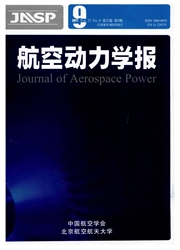

 中文摘要:
中文摘要:
将Lighthill方程转变为频域Helmholtz弱积分形式并采用Galerkin方法离散.基于声学有限元方法考虑声波在复杂固壁(叶轮和蜗壳)内的散射和反射等作用,利用Ffowcs Williams-Hawking(FW-H)方程耦合非定常流场计算结果数值预测了某离心风扇的噪声辐射,流场计算结果和蜗壳壁面动态压力测量结果在基频上吻合较好.结果表明:基频压力脉动分量在噪声源特性中占据主导地位且靠近叶轮前盖板对应位置的蜗舌区域(叶轮出口宽度范围内)是最主要的噪声源区域;声学有限元方法和实验吻合较好,复杂固壁对声传播影响不容忽略.叶轮出口不稳定气流对蜗壳周期性冲击引起的转/静干涉噪声远大于叶片偶极子源噪声是离心风扇最主要的噪声辐射分量且噪声主要从风扇管道出口方向传播.
 英文摘要:
英文摘要:
The Lighthill equation was transformed into Helmholtz equation in"weak integral form"and Galerkin method was applied to discretize the above equations.Based on acoustic finite element method(FEM),and considering the effects of scattering and reflection on the complex solid surface(impeller and volute),the Ffowcs Williams-Hawking(FW-H)equation coupling unsteady reynolds average Navier-Stokes(UANS)results were used to simulate the noise radiation of a centrifugal fan.There was a good agreement between the numerical results and dynamic pressure testing of volute casing at blade passing frequency(BPF).The results show that the BPF components dominate the acoustic sources characteristic and the volute tongue region close to shroud(belong to impeller exit width)is a primary acoustic sources region.A good agreement has been shown between acoustic FEM method and noise testing results,and the effects of complex solid surface on noise propagation cannot be neglected.The interaction noise induced by periodical impingement between non-uniform flow of impeller exit and volute casing is much bigger than blades dipole noise,serving as the primary noise component of centrifugal fan,and the primary propagation direction isfan outlet duct.
 同期刊论文项目
同期刊论文项目
 同项目期刊论文
同项目期刊论文
 期刊信息
期刊信息
